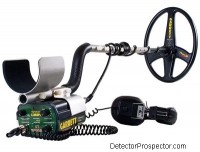
The Garrett Infinium LS (Land & Sea) was introduced in 2002 and was discontinued in 2015, replaced by the Garrett ATX. I have a particular interest in the Infinium. I am a metal detecting fanatic and one thing I want to see is better technology. I believe the best way to get that is through good old competition. Although Minelab makes fantastic ground balancing pulse induction metal detectors (the SG/GP series) I was frustrated by the fact that the U.S. manufacturers were bringing nothing to the table to compete. It seemed to me they had totally ceded that portion of the market to Minelab.
I was therefore very happy when I was contacted by Garrett Electronics Engineer Brent Weaver about testing a new metal detector prototype in Alaska. The prototype was the soon to be Garrett Infinium LS. Brent wanted to know where we could go where there was really bad ground mineralization so that he could test the unit. We took the unit to the Petersville district north of Anchorage, where there is both highly mineralized bedrock and some very nasty graphitic slate hot rocks. The Infinium handled both with ease.
I was impressed and was an early adopter of the unit. It unfortunately was over-hyped prior to release and faced some backlash from those expecting a "Minelab killer". Eventually the hubbub subsided and the Infinium has now found a niche as a very versatile ground balancing pulse induction detector with good performance at a very reasonable price. What makes the machine remarkable is that it is waterproof to 200 feet if you get the optional submersible headphones. Rare also in underwater units is that the Infinium has interchangeable search coils by way of a watertight connector. Most underwater units are hardwired with a single coil, limiting their versatility. Obviously the Infinium can be employed in environments far more adverse than most nugget detectors.
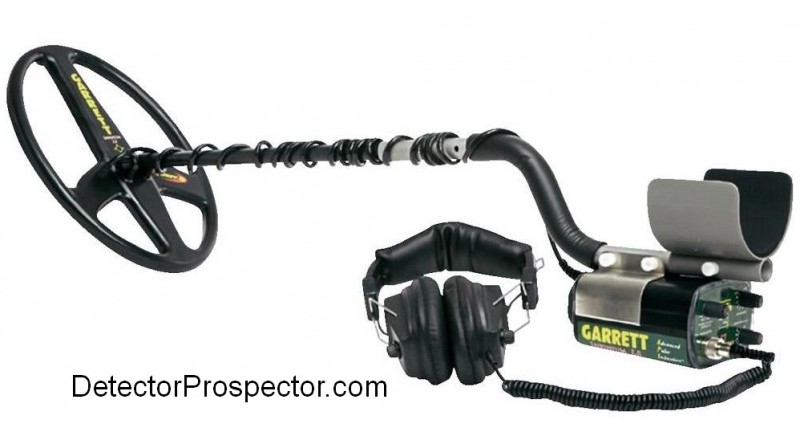
Garrett Infinium LS waterproof pulse induction metal detector
I had a lot of success using the Garrett Infinium gold nugget and jewelry detecting and have several stories about the unit at Steve's Mining Journal. See Garrett Infinium in Hawaii, Garrett Infinium at Moore Creek, and Coin Detecting with the Garrett Infinium. I also published a lot of tips on operating the unit that are detailed below the specification chart.
The Garrett Infinium was discontinued in 2015, replaced by the newer Garrett ATX.
Garrett Infinium LS Instruction Manual
Forum Threads Tagged "garrett infinium"
| Internet Price | $1062.00 (now discontinued) |
| Technology | Ground Balancing Pulse Induction (GBPI) |
| Transmit Frequency | 730 Pulses Per Second |
| Autotune Mode(s) | Slow Motion |
| Ground Rejection | Tracking (Slow or Fast) and Fixed |
| Soil Adjust | No |
| Discrimination | Dual tones plus Adjustable Pulse Delay |
| Volume Control | Supplied headphones have volume controls |
| Threshold Control | One turn control |
| Tone Adjust | No |
| Audio Boost | No |
| Frequency Offset | One turn control |
| Pinpoint Mode | No |
| Audio Output | Proprietary headphone socket (No speaker) Headphones supplied |
| Hip Mount | Yes, holster provided |
| Standard Coil(s) | 14" x 10" DD |
| Optional Search Coils | Three accessory coils available |
| Battery | 8 AA rechargeable and disposables supplied |
| Operating Time | 10 - 15 hours |
| Weight | 5.6 pounds |
| Additional Technology | Waterproof to 200 feet (requires optional submersible headphones). |
| Notes | Discontinued in 2015 |
*Notes on Technical Specifications - Detailed notes about the specifications listed in this chart.
The Garrett Infinium is a very simple detector to operate, but here are a few tips to help give you a head start. These are unofficial tips based on my own personal use of the Infinium for detecting gold nuggets, jewelry, coins, and relics.
First, here is a suggested starting procedure. Make sure the headphones are just slightly above the minimum setting. The Infinium puts out a very strong audio. Set the Discriminate control at “0”. Set the Threshold about “4”. Turn the Power on and set to the Slow ground tracking position. The machine should beep 4 times indicating fully charged batteries, three times if less charge, two times if low, once, you’d better replace right now. A continuous tone indicates the batteries are below operating condition. No sound? Check your stereo/mono switch and volume controls on your headphones. Wave the coil over a target and adjust the headphones for a comfortable sound on the loudest targets. Then tweak the threshold for a barely discernable tone.
Pulse Induction (PI) detectors have extremely sensitive receiver circuits. This means that they are much more prone to picking up outside electrical interference than standard metal detectors. This interference can be from power lines, substations, radio transmitter, lightning, and other metal detectors, to name a few. In populated areas some kind of faint sounds and intermittent signals are inevitable. Some areas can be virtually unsearchable due to interference.
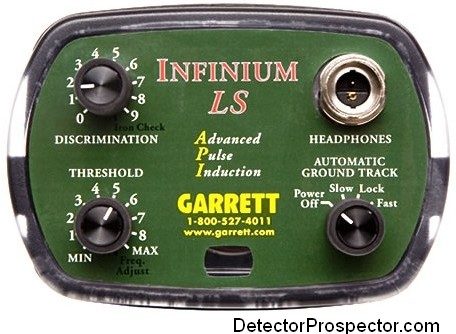
Garrett Infinium Controls
There are several solutions to the problem. First and most important is the Frequency Adjust control. Rotate the Threshold control as far to the right as it will go. Then turn the Discriminate control to far left. Now listen to the detector. The Discriminate control is now actually a Frequency Adjust control. It has 32 separate positions. Unfortunately, the 32 positions are not marked! So turn the knob a tiny amount to the right and wait a couple seconds. The machine interference may be reduced, may increase, or may stay the same. Then advance again a tiny amount, and listen a couple seconds. The idea is to slowly advance through the different settings looking for the quietest.
Once you find the quietest setting, turn the Threshold control back to about “4”. This will lock in the Frequency setting, and it will remain set until you adjust it to something else. Be sure and rotate the Discrimination control back to “0” and you are set to detect.
One thing that helps a lot is to keep the coil flat on the ground. In town the coil is like an antenna, and lifting it at an angle off the ground can massively increase the interference. So making the above adjustment with the coil flat on the ground will usually be the way to go.
In populated areas, you will still be likely to receive faint noises and spurious false signals. Like most false signals, the key is repeatability. Real signals repeat over a certain spot, false signals come out of nowhere and then are gone. I tend to run my VLF detectors on the ragged edge of performance, with the gain set high. In doing so I get lots of false blips and tiny signals. So I've long since learned to ignore this kind of noise. But for beginners it can be difficult to deal with. Remember - repeatable signals are the real ones.
DD coils are less prone to interference than mono coils, and smaller coils are less prone than larger coils. So a change of coils may help. Finally, as most of these false signals are fainter than most genuine targets, reducing the threshold slightly lower than normal can eliminate most of them while still getting all but the faintest real signals.
I have been able to operate in town near power lines with quite a bit of background noise. I set my headphones very quiet and listen more to the tone of the signals than the volume. Genuine signals simply sound different than the noise produced by the electrical interference. But if the noise gets bad enough, it can be a real obstacle to pleasant detecting and some areas will simply be off-limits to the Infinium. But please do not take this explanation to mean this is a major issue. It is something all PI detectors face to varying degrees in areas where there are many electrical sources. In unpopulated areas the Infinium is very quiet with a very smooth threshold, except rare blips that may come from distant lightning.
As far as the Power/Tracking settings go, I’ve been able to discern little difference between the settings. I generally just set my Infinium on “Slow” and forget about it. In theory, you may be able to hit slightly smaller or deeper targets by switching to “Fixed” after the machine tracks into the ground for a couple minutes, but I have noted no real improvement myself. The “Fast” setting is supposed to help with the worst ground conditions, but again, I have not seen a situation where I felt it made a difference. So “Slow” it is for me.
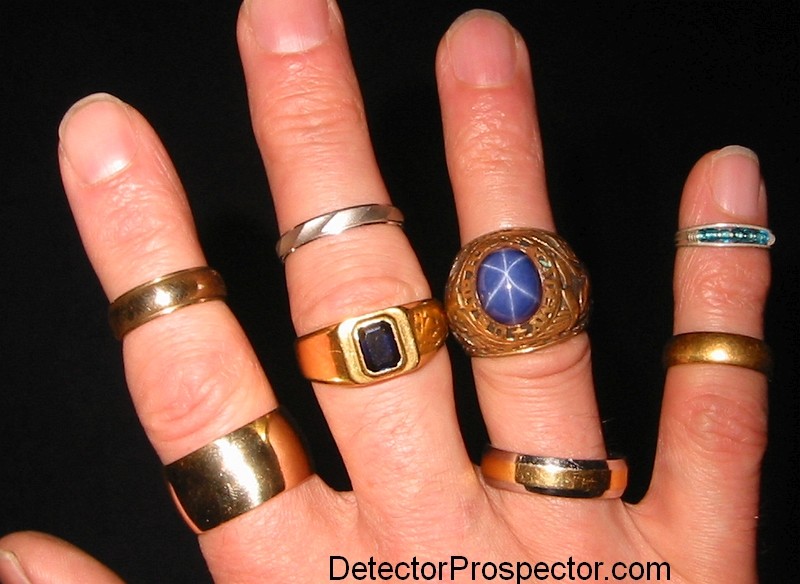
All found by Steve with Garrett Infinium except small gold ring on pinky finger
My view of the Discriminate control does not agree at all with what it is billed as. I’ve played with it a lot, and as far as I am concerned it acts just like a sensitivity or gain control. At “0” you have max sensitivity to small items, and max depth. As you advance the control, you lose overall sensitivity. Low conductive targets are affected the most. So the "Reverse Discrimination" theory is that if you advance the control all the way and still get a signal, it is junk. If it disappears, you are supposed to dig it.
Well, it does not work that I can see. All that happens in reality is the weakest signals are eliminated and strong signals remain. Big junk at the edge of detection depth has a weak signal, and so this “Reverse Discrimination” method calls it good since the Discrimination control causes it to disappear. Conversely, a 2 ounce gold nugget an inch down responds no matter what. So it should not be dug?
Nope, forget all that. The discrimination control can be thought of as a sensitivity control, just like that on a VLF detector. Reducing the sensitivity by advancing the control above “0” can reduce ground noise, particularly in salt water environments. If you are getting lots of ground signals or hot rocks that will not track out, try advancing the Discriminate control to eliminate them. If you are having a problem with tiny trash items, advancing the Discriminate control can eliminate some of them. But the more you advance the control, the less overall depth you will get on most targets. But just like lowering sensitivity or gain on a VLF detector can result in smoother operation and actually better performance, so advancing the Discriminate control on the Infinium to reduce unwanted signals can result in better overall performance.
ads by Amazon...
Finally, the best is last. The dual tone discrimination on the Infinium really does work, and work well. The catch is it might not work like you think it should!
A hi-lo tone means aluminum, gold, nickels, zinc pennies, and various wire-like items. Like small, thin nails, bobby pins, and actual wire. Some thin, flat, flaky rusted steel reads hi-lo. If nugget detecting or beach detecting, hi-lo tones are the ones to go after to get the gold nuggets and gold jewelry.
Silver, copper, and clad coins read lo-hi. As does larger steel junk or relics. Want old silver deeper than any VLF detector will detect? Dig lo-hi tones. You will come up with larger, heavily rusted items of all sorts but you will be amazed by the depth you pull up coins with an Infinium. The worse the ground mineralization, the more advantage the Infinium will have over VLF detectors. Try digging lo-hi tones only, and you will find deep coins others are missing. See Coin Detecting with the Garrett Infinium for details.
You can use the discriminate control in conjunction with the dual tones to get a bit more information about the target. I have found in actual practice, however, that I rely strictly on the tones for making my digging decisions. Gold - always dig hi-lo tones. Silver coins - always dig lo-hi tones.
In very trashy locations it pays again to keep headphone volume low so as not to be overwhelmed by the signals. I have a favorite freshwater beach I hunt. It is hunted to death, and VLF detectors can barely find any targets. My Infinium made the beach seem like it had never been detected. There are signals everywhere. Sure, I’m digging iron junk, and lots of aluminum. But I’m pulling up old coins passed over by thousands of detectors. The biggest catch is you need a location where digging large deep holes is ok… and backfill them! A good pinpointer like the DetectorPro Uniprobe is a major help also.
You will also find that on shallow or very large targets the audio will "stick" or drag on for a longer than normal time. In other words, a deep coin will give a nice little tone similar to what a VLF might. But the same coin an inch below the surface will exhibit this "dragging tone" effect. Bury a quarter at 8" and one at 1" and note the difference. This effect can be used to determine the size and depth of targets. Be careful in trashy areas, as closely spaced targets can be "masked" by the effect. A dragging tone from a shallow junk item can cause an adjacent deep good item to be missed. Moving very slow in trashy sites helps considerably.
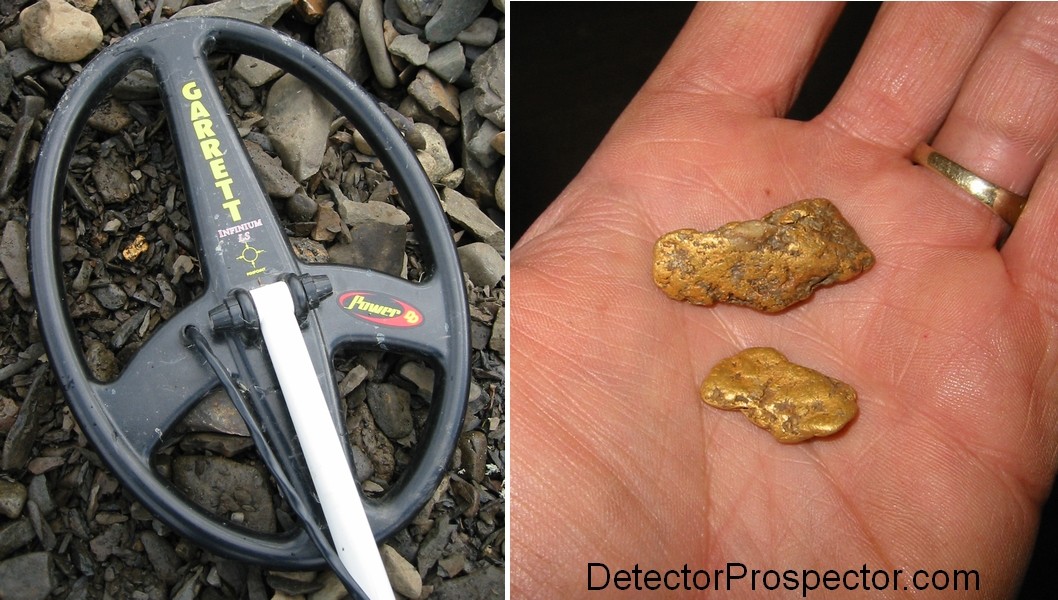
Gold nuggets found at Ganes Creek, Alaska by Steve with Garrett Infinium
Nugget detecting with the Infinium is pretty much a no-brainer. Most mining areas will have no interference issues, except perhaps other detectors. I prefer to hip mount the Infinium for long hours of detecting. I keep it on the rear of my hip so that I do not stress the coil wire when bending over. Make sure and get a coil cover for nugget detecting as rocks and gravel are rough on coils. The stock 14" x 10" DD coil is probably best for most nugget detecting applications, but it is nose-heavy when the control box is hip mounted. If ground conditions allow the 14"x10" mono is lighter and will get slightly better depth in mild ground. I like the 10" x 5" DD for hip mounting applications, as the wand/coil combo is very light and works well is steep terrain or thick brush. If you do get into heavy iron junk, oversize iron reads lo-hi, while nearly all gold nuggets read hi-lo. But when possible dig it all!
Tidbits... The 14" x 10" mono coil is much easier to pinpoint with than the DD version and gets a bit more depth dead center. But it is nosier in areas with electrical interference and if used nugget detecting will hit hot rocks more than the DD coil. Still, it is my favorite coil. The 8" round mono coil is very popular with lots of people. Mono coils are more sensitive around the edges than in the center, so tiny surface targets will signal at each edge, giving a double blip. It also makes pinpointing these tiny items hard - try dragging one edge along the ground. The little 7" x 3" DD is the most sensitive to small items and is fantastic for working trashy sites, but like most small coils does not cover ground well and gives up overall depth. I prefer it for wading at I can pinpoint and scoop so well with it, and it is great for nugget detecting deep nooks and crannies. To pinpoint excavated items in a pile of dirt with the elliptical coils, try dragging the coil pointed end down in the dirt. The target will signal directly off the nose of the coil. For those so inclined, I cut my Garrett headphones off a few inches above the waterproof connector. I wired a 1/4" female receptacle onto the end creating a "dongle" into which I can plug any headphones. You can put a 1/4" male jack onto the Garrett phones so as not to waste them. One thing to look out for are large elongated steel items. Like a steel strap a foot long or a long spike. These can signal well off one end or the other. Again, a powerful pinpointer can help with un-centered targets.
I hope these notes help. The main thing to remember is that this is a radically different detector than any VLF machine. In some ways it is like the early, cruder VLF detectors. Weird operating methods, poor discrimination… but genuine raw power is the reward. Be patient and dig it all for awhile, and I promise you will make finds with the Infinium that would not be possible with a VLF detector. Parting word - keep the coil low, and swing it slow! PI detectors do not like air space between the coil and ground, and are slower to respond than VLF detectors.
~ Steve Herschbach
Copyright © 2004 Herschbach Enterprises
-
 3
3





